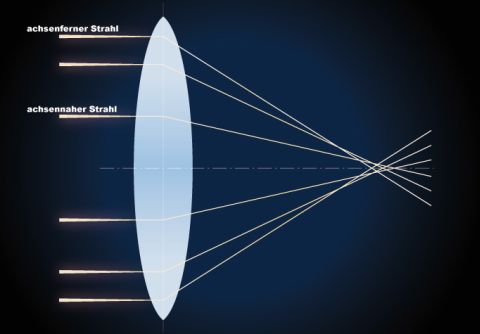Aberration
They affect the appearance of what you see and cause poor images. It’s good to know what to look out for...

Aberration in binoculars
There is aberration in all optical systems. Neither our own eyes nor man-made binoculars or telescopes are free of aberration. These errors are mainly: colour variations, distortion, field curvature due to spherical deviation and astigmatism. The further a light ray is from the optical axis, the greater the aberration can become. In binoculars, chromatic aberration and blurred edges are the most significant defects.
1. Chromatic aberration

Colour fringes are visible in many binoculars, especially in the low-cost sector. They are particularly noticeable when you look at sunlit objects or, for example, an illuminated street lamp. Usually, an observer will notice bluish fringes around the object. Chromatic aberration is an error that occurs with optics that contain one or more components in which light is refracted, i.e. bent. Blue light is refracted more strongly than, for example, red light. This means that the different wavelengths have different focal lengths. The refractive index of blue light is greater than that of red light.

The difference between red and blue
When light passes through a convex lens, it is bent towards the optical axis. Due to their different wavelengths, blue light is deflected more than red light. Longitudinal chromatic aberration arises, which results in colour fringing in the image. Two-lens systems are used in modern binoculars. Blue and red light are corrected and brought together by the refractive index of the lens.
The most noticeable colour fringing disappears and only a residual chromatic aberration, also known as the secondary spectrum, remains.
If you think of this in practice with the image of an object, you can say that the blue light is to be found at a different point to the red light. This set of circumstances produces blurring of the image. But not only that, because there is also a colour-related magnification difference. Simply put, this means that, due to the different image distances, different sized images for the respective colours are also produced. This produces the colour fringing.
Binoculars with reduced chromatic aberration
In order to reduce chromatic aberration, a two-lens system is generally used in binoculars. The second lens has different properties to the first. The front lens element usually consists of a collecting lens of low dispersion and a diverging lens of greater dispersion, which are cemented together. Blue and red are then combined at the back focal point, which means that the binoculars are corrected for these colours.
This type of optic is known as achromatic. Practical tip: an optical device’s colour error manifests itself during observation as a colour fringe, which becomes visible at the outer edges of the object.
2. Blurred image

In binoculars, all too often you will notice a decrease in sharpness toward the edge. Depending on the binoculars, this blurring ranges from severe to barely noticeable. The reason for this phenomenon is the varying incident light ray height in relation to the optical axis. The focal point position varies due to the higher angle of incidence and the associated surface curvature.
In the actual image, the blurring at the edges will not be as extreme as in this picture. Nevertheless, the effect is the same.
In an optical experiment, you would observe that the light rays meet at different focal lengths. This error, also called spherical aberration, can be reduced by the use of aspherical lenses. Combinations of lenses, which correct spherical aberration, are also possible.

In the case of a spherical curved lens surface, a ray of light further from the optical axis is refracted more strongly than a ray closer to the axis. Different focal points arise, depending on the height of incidence. In combinations of convex and concave lenses, this error can usually be effectively corrected. Spherical aberration can cause blurring of the image.

